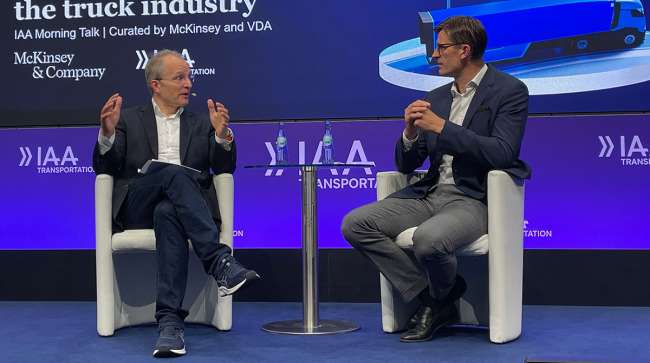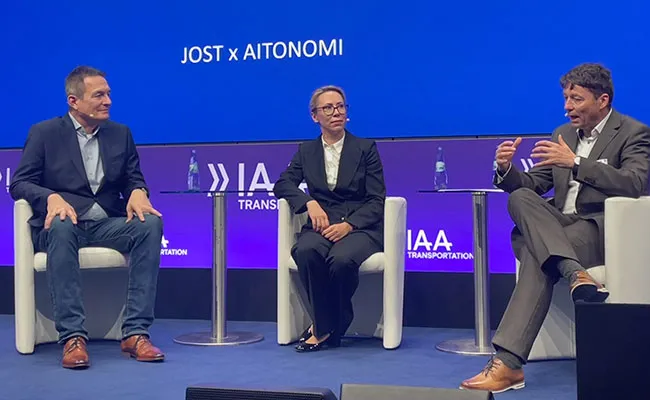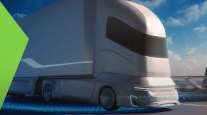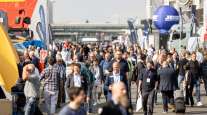Increased Connectivity Is Driving Innovation and Automation

[Stay on top of transportation news: Get TTNews in your inbox.]
HANOVER, Germany — New vehicle architectures and connectivity are enabling data sharing, value-added services and new solutions for fleets and equipment manufacturers that can help increase efficiency and speed innovation.
“We’ve entered the age of software-centric vehicles. It isn’t the hardware, it is the software, leading the vehicle,” said Rupert Stuetzle, general manager of manufacturing and mobility at Microsoft.
The increase in software and electronics demands back-end connectivity.
“They need hybrid cloud concepts where you have a good architecture that allows you to collaborate what you do in the vehicle and what you do in the cloud,” Stuetzle said at IAA Transportation 2024.
Connectivity is taking on greater importance as production of zero-emission vehicles increases, because fleets have to plan and enable charging.
“That is a bigger challenge than for ICE vehicles,” he explained.
The ability to combine and share data is also enabling greater collaboration within the industry going beyond traditional bilateral partnerships.

Aitonomi CEO Torsten Scholl (left) and Chief Operating Officer Xenia Scholl discuss the importance of information sharing and strategic partnerships with Michael Fischer of Jost. (Mindy Long for Transport Topics)
“Now you work together with a lot of players, and you might partially compete with those players. You can make it work to everybody’s advantage,” Stuetzle said.
Torsten Scholl, CEO of Aitonomi, which manufactures self-driving vehicles, said partnerships are essential for innovation.
“We have to understand, as industry, we have to talk to each other because we have to open our minds to a more diverse view to add a whole new domain of expertise,” he said. “That extends our ability to come up with innovation.”
Aitonomi recently partnered with Jost International for couplings on its autonomous transport systems for pallets. The equipment has to couple and uncouple by itself, and the Jost solution helped reduce coupling time from 10 to 15 minutes to 2 to 3 minutes.
More From IAA
Clarios: AI-enhanced batter monitoring for fleets
OEMs: Consortium to standardize EV truck charging
PepsiCo: Private fleet adds EV trucks to boost cost savings
Batteries: Low-voltage power demands drive solutions
Attendance: IAA sets a record for the event
“When we understand what the pain point for the customer is and what his problem is, we can tap him for that value pool,” said Michael Fischer, vice president of global research and development for Jost.
Stuetzle expects research and development to benefit the most from advances in generative AI and said it will help companies innovate even faster.
“There is a lot that can be automated,” he explained. “You can try to extract requirements from legislation and regulation documents, and you can test requirements for redundancy and do quality checks,” he said. “There is an immense opportunity to capture data in the field and feed it back to engineering.”
TT's Seth Clevenger and Erika Voss of DAT Freight and Analytics discuss crucial strategies and best practices for safeguarding information and assets in a high-demand period. Tune in above or by going to RoadSigns.ttnews.com.
For example, engineers could ask to see charging anomalies, and generative AI could give engineers the precise information they need. Previously, an analyst would have to pull data and slice and dice it.
“With GenAI, we’re introducing a new interface so you can interact in a normal language,” Stuetzle explained. “An engineer can specify what he wants to see.”
AI also can check the quality of requirements. Stuetzle said Microsoft’s Copilot AI solution is widely established in the automotive industry and has created efficiency gains of up to 50%. However, it won’t replace people.
“It is an assistant function. We call it Copilot because there is still a pilot,” he said, adding that the technology can free up employees’ capacity for other tasks.
As data takes on more importance, optimized telematics platforms and data standardization become essential.
“What is necessary is to deploy the latest technology so you can use the data for improving those systems and improving your operations,” Stuetzle said. “Everybody is looking to the open-source concept to pull resources.”
Governance and security also are critical.
“There is a lot of focus on data security to avoid IP leakage,” Stuetzle said. “The hackers will always be a step ahead of us and we need to catch up.”
Want more news? Listen to today's daily briefing below or go here for more info:





